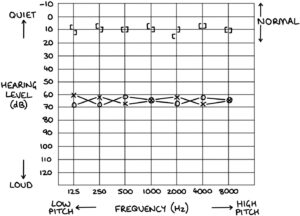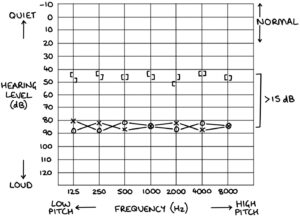Audiometry involves testing a patient’s hearing by playing a variety of tones and volumes using headphones (air conduction) and a bone conduction device (oscillator) that delivers sound directly to the bones of the skull. Audiometry results are recorded on an audiogram. Audiograms can help identify and differentiate conductive and sensorineural hearing loss.
Audiogram
Audiograms are charts that document the volume at which patients can hear different tones. The frequency in hertz (Hz) is plotted on the x-axis, from low to high pitched. In decibels (dB), the volume is plotted on the y-axis, from loud at the bottom to quiet at the top. The lower down the chart, the higher the decibels and the louder the volume. The higher up the y-axis, the more sensitive the hearing.
Hearing is tested to establish the quietest volume at which a patient can hear each frequency. This level is plotted on the chart. The louder the sound required for the patient to hear, the worse their hearing is and the lower on the chart they will plot. For example, a 1000 Hz sound will be played at various volumes until the patient can just about hear the sound. If this tone is heard at 15 dB, a mark is made on the chart where 1000 Hz meets 15 dB. If this sound can only be heard at 80 dB, a mark is made where 1000 Hz meets 80 dB.
Hearing is tested in both ears separately. Both air and bone conduction are tested independently. The following symbols are used to mark each of these separate measurements:
- X – Left-sided air conduction
- ] – Left-sided bone conduction
- O – Right-sided air conduction
- [ – Right-sided bone conduction
When a patient has normal hearing, all readings will be between 0 and 20 dB, at the top of the chart.

In patients with sensorineural hearing loss, both air and bone conduction readings will be more than 20 dB, plotted below the 20 dB line on the chart. This may affect only one side, one side more than the other or both sides equally.

In patients with conductive hearing loss, bone conduction readings will be normal (between 0 and 20 dB). However, air conduction readings will be greater than 20 dB, plotted below the 20 dB line on the chart. In conductive hearing loss, sound can travel through bone but is not conducted through air due to pathology along the route into the ear.

Both air and bone conduction readings will be more than 20 dB in patients with mixed hearing loss. However, there will be a difference of more than 15 dB between the two (bone conduction > air conduction).

Last updated July 2021
Now, head over to members.zerotofinals.com and test your knowledge of this content. Testing yourself helps identify what you missed and strengthens your understanding and retention.

